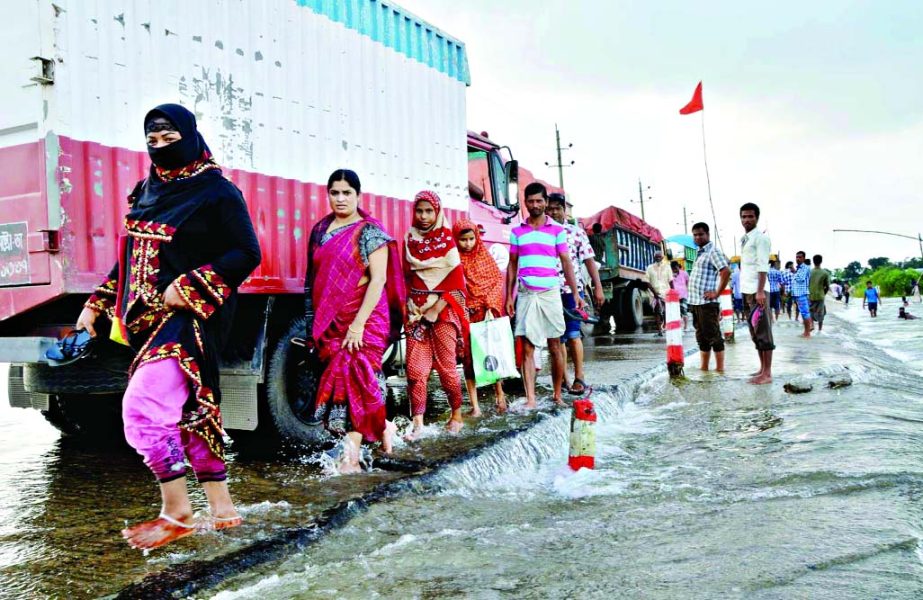
Staff Reporter :Trail of destructions by the flood have been causing untold sufferings to the home returning people along with the outbreak of water borne diseases as the river waters continued to recede fast in the northern and north-eastern districts of the country.Normalcy has been gradually returning to the flood affected areas as many displaced people already returned to their homes following the improvement of the flood situation in the Brahmaputra basin.The monsoon floods that first battered the northern districts towards the beginning of August, have affected several lakh people, damaging tens of thousands homesteads of people and thousands of hectares of croplands.The major rivers and tributaries were flowing below their respective danger mark at all points, except Sariakandi in Bogra, yesterday following further recession in their water levels during the period, officials in the Water Development Board (WDB) said. With the recession of water levels in the major rivers and tributaries, severe erosions have started devouring many houses with land and properties along the riversides in Kurigram, Gaibandha and Bogra districts.As reported, shortage of food, pure drinking water, sanitation, medicine and fodder for domestic animals have increased the sufferings of the flood-hit people. Besides, there were reports of the out break of diarrhoea and other water-borne diseases in the flood affected areas. People, who have just returned to their homes, are now passing their days with countless measures as well as in an inhuman condition. They are mainly facing scarcity of safe drinking water, as most of the tube-wells in flood affected areas have become inoperative.Different civil surgeons office sources said that a huge number of flood victims have been infected by diarrhoea, respiratory tract infection, skin diseases, eye infection and by other diseases, including dysentery, fever and cold-related complications.According to district fisheries departments, fishes in many ponds and water bodies across the country were washed away by floodwater causing a loss of crores of taka.The Department of Agriculture Extension offices have suggested farmers to replant the seedlings of late variety Aman paddy like Nazirshail and Ganzia paddy in the affected areas. If it was not possible, they have advised to go to farm early variety of robi crops to get desired yields to recoup the losses caused by flood. Meanwhile, Nilphamari, Rangpur and Lalmonirhat districts are now flood-free while the situation is improving fast in Kurigram, Gaibandha, Bogra and Sirajganj, said the Flood Forecasting and Warning Centre. It added that a complete normalcy is likely to return in the low-lying char areas by the next couple of days.The government has so far allocated 3,700 tonnes of rice and Tk 71.50 lakh for distribution among the flood affected people of Rangpur, Nilphamari, Lalmonirhat, Kurigram, Gaibandha, Bogra and Sirajganj districts.Of them, the district administrations have so far allocated 2,532.40 tonnes of rice and Taka 41.40 lakh and upazila administrations in association with local public representatives have been distributing those among the affected people.According to official sources, 10.89 lakh people of 2.78 lakh families have been affected by current flood in these riverside districts where the flood situation continues improving now.Sources in the Department of Agriculture Extension (DAE) said standing crops on 78,589 hectares of land were submerged under floodwater this time in seven affected northern districts along the Brahmaputra basin. The submerged crops include growing fields of Transplanted Aman on 66,378 hectares of land, Aman seedbed on 973 hectares, ripe Aus on 4,839 hectares, vegetables on 1,919 hectares, Buna Aman on 4,225 hectares and other crops on 255 hectares of land. A Flood Forecasting and Warning Centre yesterday said that 16 river stations have marked rises while 62 stations recorded falls. It further said among the 83 monitored water level stations, water levels at six monitored river stations are flowing above their respective danger marks while two river stations have remained steady. The Atrai at Baghabari, the Dhaleswari at Elasin, the Kaliganga at Taraghat, the Dhaleswari at Jagir, the Kushiyara at Sherpur and the Kangsha at Jariajanjail were flowing above their respective danger levels by 19cm, 31cm, 10 cm, 14 cm, 4 cm and 37 cm yesterday.According to Water Development Board sources, the Brahmaputra was flowing below its danger mark by 155cm at Noonkhawa, 62cm at Chilmari and 86cm at Fulchhari points yesterday following further sharp falls in the water levels during the past 24 hours.The Jamuna was also flowing 34cm below its danger mark at Bahadurabad, 39cm at Sirajganj and 56cm at Aricha pints while it was flowing only 8cm above the danger mark at Sariakandi points.The Teesta was flowing below its danger mark by 50cm at Dalia, 165cm Kawnia and 135cm at Sundarganj, Dharla by 106cm at Kurigram and Ghaghot by 48cm at Gaibandha points.

